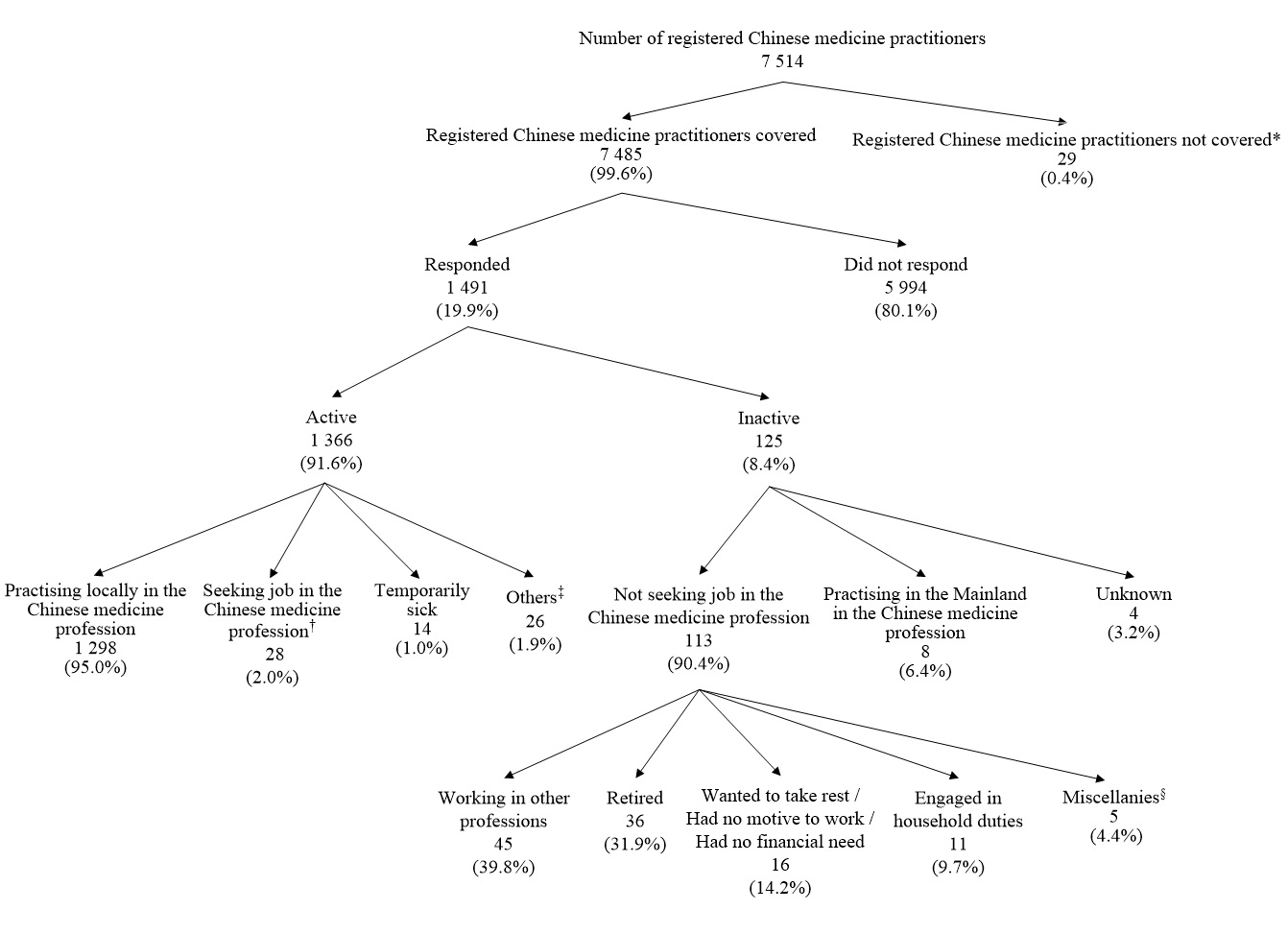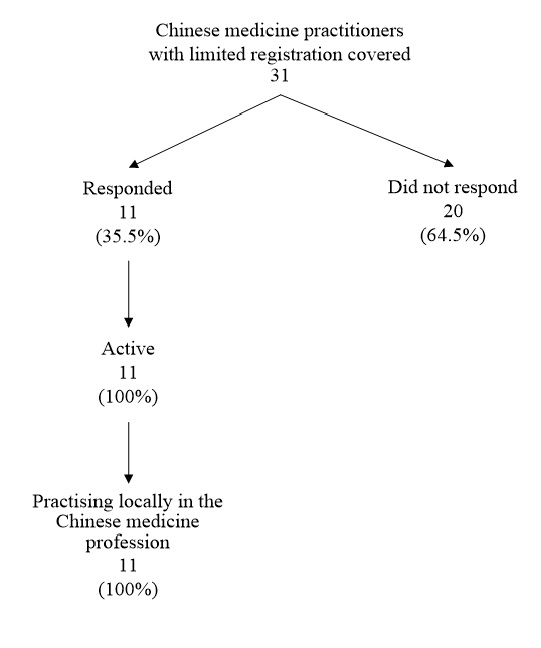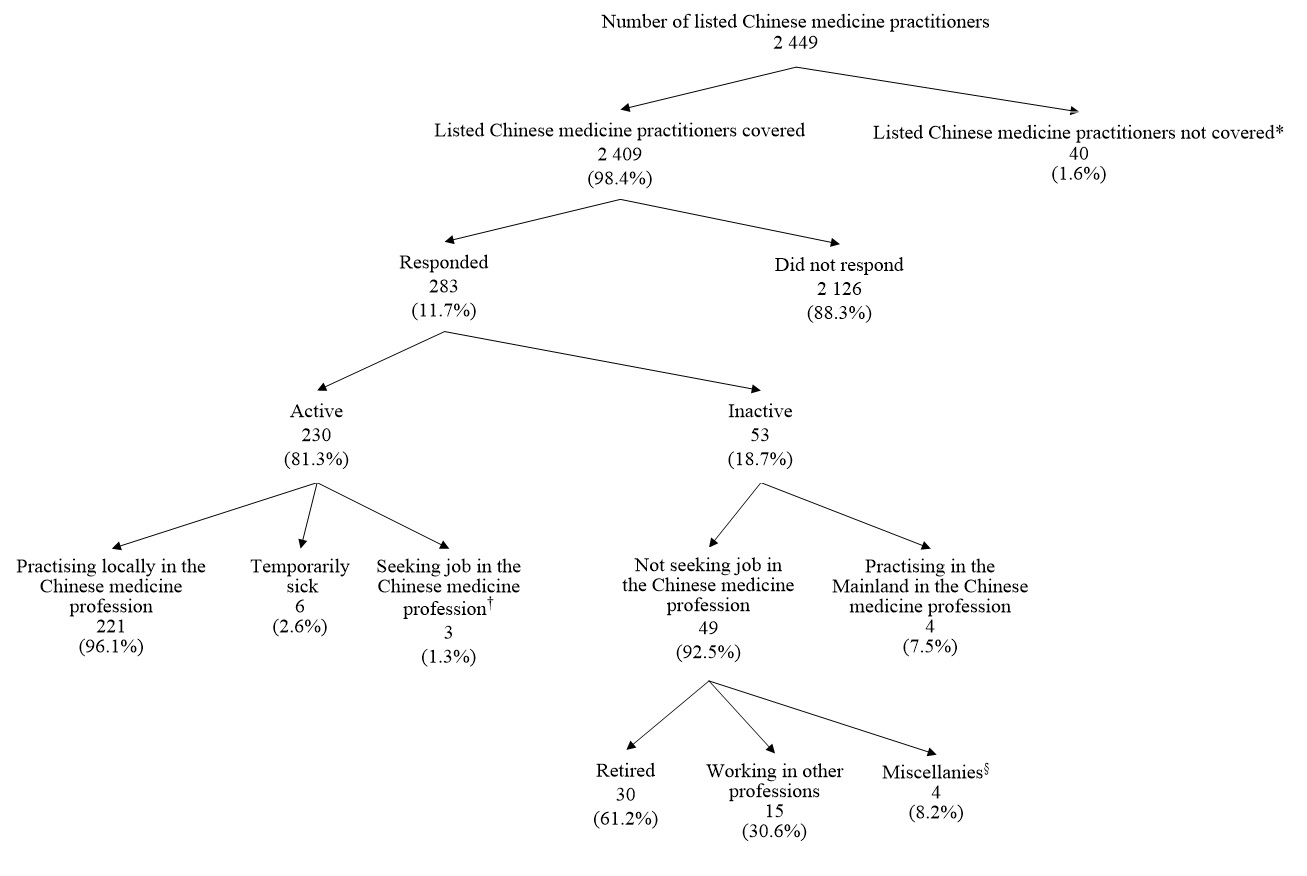Statistics
2020 Health Manpower Survey on Chinese Medicine Practitioners
Key Findings
The Chinese medicine practitioners covered in the 2020 Health Manpower Survey (the survey) were Chinese medicine practitioners registered* with the Chinese Medicine Council of Hong Kong or entered on the list of listed Chinese medicine practitioners maintained by the Chinese Medicine Council of Hong Kong under the Chinese Medicine Ordinance (Chapter 549) as at the survey reference date of 31.8.2020.
The number of Chinese medicine practitioners covered was 9 925, which included 7 485 (75.4%) registered Chinese medicine practitioners, 31 (0.3%) Chinese medicine practitioners with limited registration and 2 409 (24.3%) listed Chinese medicine practitioners.
Of the 9 925 Chinese medicine practitioners covered, 1 785 responded to the HMS - CMP, giving an overall response rate of 18.0%. The response rate of registered Chinese medicine practitioners was 19.9%, while that of Chinese medicine practitioners with limited registration and listed Chinese medicine practitioners were 35.5% and 11.7% respectively.
Registered Chinese Medicine Practitioners
Among the 1 491 responding registered Chinese medicine practitioners, 1 366 (91.6%) were “active”†‡ and 125 (8.4%) were “inactive”†§ in the local Chinese medicine profession as at 31 August 2020 (See Chart A).
Of the 1 366 active registered Chinese medicine practitioners enumerated, 1 298 (95.0%) were practising in the local Chinese medicine profession, 28 (2.0%) were seeking jobs and 14 (1.0%) reported that they had not been available for work because of temporary sickness. Among the 1 366 respondents, 26 (1.9%) reported that they were available for work but had not sought work during the 30 days before the enumeration due to reasons including: expecting to return to their original jobs; waiting to take up a new job; starting business at subsequent date; or believed that work was not available in the local Chinese medicine profession.
| * | Includes all registered Chinese medicine practitioners and Chinese medicine practitioners with limited registration. |
| † | In the survey, the criteria used in defining economically active / inactive followed those recommended by the International Labour Organization, which are also being used by the Census and Statistics Department in Hong Kong. |
| ‡ | Economically active (“active”) Chinese medicine practitioners included: (a)“employed” Chinese medicine practitioners - Chinese medicine practitioners practising in the Chinese medicine profession in Hong Kong during the survey period; and (b)“unemployed” Chinese medicine practitioners - Chinese medicine practitioners who (i) were not practising in the local Chinese medicine profession during the survey period; (ii) had been available for work during the seven days before the survey AND (iii) had sought work in the local Chinese medicine profession during the 30 days before the survey. The respondent would be classified as “unemployed” if he/ she had sought work but had not been available for work because of temporary sickness. The respondent would also be classified as “unemployed” if he/ she fulfilled conditions (i) and (ii) but had not sought work during the 30 days before enumeration because he/ she believed that work was not available; or had made arrangements to take up a new job; or start business on a subsequent date; or was expecting to return to the original job in the local Chinese medicine profession. |
| § | Economically inactive (“inactive”) Chinese medicine practitioners referred to the responding Chinese medicine practitioners who were not practising in the Chinese medicine profession in Hong Kong during the survey period, excluding those who were on leave during the survey period and who were “economically active” but “unemployed”. |
The survey results presented below were based on the 1 298 responding registered Chinese medicine practitioners who were practising in the local Chinese medicine profession as at 31 August 2020. The percentages presented below may not add up to 100% due to missing responses or rounding.
- After excluding one active registered Chinese medicine practitioner practising in the local Chinese medicine profession enumerated who did not indicate the gender, among the remaining 1 297 active registered Chinese medicine practitioners enumerated who were practising in the local Chinese medicine profession, there were 806 (62.1%) male and 491 (37.9%) female, giving an overall sex ratio (males per 100 females) of 164. Excluding 12 respondents who did not indicate their age, the median age of the remaining 1 286 active registered Chinese medicine practitioners practising in the local Chinese medicine profession enumerated was 60.0 years (median age of female was 53.0 years and median age of male was 63.0 years).
- The responding active registered Chinese medicine practitioners practising in the local Chinese medicine profession were requested to indicate the characteristics of their main jobs*. Among the 1 298 respondents, 1 131 (87.1%) of them reported as working in the private sector, 83 (6.4%) in the subvented sector, 42 (3.2%) in the academic sector, 30 (2.3%) in the Hospital Authority and four (0.3%) in the Government.
- Of the 1 298 active registered Chinese medicine practitioners practising in the local Chinese medicine profession enumerated, 80.4% spent most of their working time on clinical general practice, while 10.8% reported spending most of their working time on clinical bone-setting and 6.4% reported clinical acupuncture as the main area of work.
- The median number of hours of work per week (excluding meal breaks) of the 1 298 active registered Chinese medicine practitioners practising in the local Chinese medicine profession enumerated was 40.0 hours, amongst which 170 (13.1%) were required to undertake on-call duty (excluding normal duty), with a median of 12.0 hours of on-call duty (excluding normal duty) per week.
Of the 125 inactive registered Chinese medicine practitioners (See Chart A):
- 113 (90.4%) registered Chinese medicine practitioners reported not practising in the local Chinese medicine profession and not seeking jobs in the local Chinese medicine profession, the main reasons included: 45 (39.8%) were working in other professions, 36 (31.9%) were retired, 16 (14.2%) wanted to take a rest / had no motive to work / had no financial need and 11 (9.7%) were engaged in household duties etc.
- Eight (6.4%) reported practising in the Mainland and four (3.2%) did not indicate the reason for being inactive.
| * | Main jobs referred to the jobs in which the registered Chinese medicine practitioners had spent most of their working time. |
Chart A: Activity Status of Registered Chinese Medicine Practitioners Covered

| Note: | * | Figure refers to the number of registered Chinese medicine practitioners subsequently found to have passed away on or before 31.8.2020. |
| † | Figure refers to the number of responding registered Chinese medicine practitioners who (a) were not practising in the Chinese medicine profession in Hong Kong during the survey period; (b) had been available for work during the seven days before the survey; AND (c) had sought work in the Chinese medicine profession during the 30 days before the survey. | |
| ‡ | Figure refers to the number of responding registered Chinese medicine practitioners who (a) were not practising in the Chinese medicine profession in Hong Kong during the survey period; (b) had been available for work during the seven days before the survey; AND (c) had not sought work during the 30 days before enumeration because he/ she believed that work was not available; or had made arrangements to take up a new job; or start business on a subsequent date; or was expecting to return to the original job in the local Chinese medicine profession. | |
| § | Figure refers to the number of responding registered Chinese medicine practitioners who reported undertaking study, emigrated, etc. | |
| Percentages may not add up to 100% due to rounding. |
Chinese Medicine Practitioners with Limited Registration
All the 11 responding Chinese medicine practitioners with limited registration were “economically active” *† in the local Chinese medicine profession (See Chart B).
The survey findings presented below were based on the 11 responding Chinese medicine practitioners with limited registration practising in the local Chinese medicine profession as at 31.8.2020. The percentages presented below may not add up to 100% due to missing responses or rounding.
- The 11 respondents included nine (81.8%) male and two (18.2%) female, giving an overall sex ratio (males per 100 females) of 450. The median age was 58.0 years (female median age was 60.0 years and male median age was 58.0 years).
- The responding active Chinese medicine practitioners with limited registration practising in the local Chinese medicine profession were requested to indicate the characteristics of their main jobs‡. The 11 respondents all reported as working in the academic sector.
- Of the 11 active Chinese medicine practitioners with limited registration practising in the local Chinese medicine profession enumerated, 90.9% reported spending most of their working time on teaching and 9.1% reported clinical general practice.
- The median number of hours of work (excluding meal breaks) per week of the 11 respondents was 40.0 hours. One (9.1%) of the respondents was required to undertake on-call duty (excluding normal duty).
| * | In the survey, the criteria used in defining economically active / inactive followed those recommended by the International Labour Organization, which are also being used by the Census and Statistics Department in Hong Kong. |
| † | Economically active (“active”) Chinese medicine practitioners included:(a)“employed” Chinese medicine practitioners - Chinese medicine practitioners practising in the Chinese medicine profession in Hong Kong during the survey period; and(b)“unemployed” Chinese medicine practitioners - Chinese medicine practitioners who (i) were not practising in the local Chinese medicine profession during the survey period; (ii) had been available for work during the seven days before the survey AND (iii) had sought work in the local Chinese medicine profession during the 30 days before the survey. The respondent would be classified as “unemployed” if he/ she had sought work but had not been available for work because of temporary sickness. The respondent would also be classified as “unemployed” if he/ she fulfilled conditions (i) and (ii) but had not sought work during the 30 days before enumeration because he/ she believed that work was not available; or had made arrangements to take up a new job; or start business on a subsequent date; or was expecting to return to the original job in the local Chinese medicine profession. |
| ‡ | Main jobs referred to the job in which the Chinese medicine practitioners with limited registration had spent most of their working time. |
Chart B : Activity Status of Chinese Medicine Practitioners with Limited Registration Covered

Listed Chinese Medicine Practitioners
Among the 283 listed Chinese medicine practitioners who had responded to the survey, 230 (81.3%) were active *† and 53 (18.7%) were inactive *‡ in the local Chinese medicine profession (See Chart C).
Of the 230 active listed Chinese medicine practitioners enumerated, 221 (96.1%) were practising in the local Chinese medicine profession. The remaining nine respondents who were not practising in the local Chinese medicine profession included six (2.6%) who reported as having temporary sickness and three (1.3%) who were seeking jobs in the local Chinese medicine profession during the 30 days before the survey.
The survey results presented below were based on the 221 responding listed Chinese medicine practitioners practising in the local Chinese medicine profession as at 31 August 2020. The percentages presented below may not add up to 100% due to missing responses or rounding.
- The 221 active listed Chinese medicine practitioners practising in the local Chinese medicine profession enumerated included 175 (79.2%) males and 46 (20.8%) females, giving an overall sex ratio (males per 100 females) of 380. The median age was 67.0 years (female median age was 66.0 years; male median age was 67.0 years).
- The responding active listed Chinese medicine practitioners were requested to indicate the characteristics of their main jobs§. The majority (216 out of 221 respondents, 97.7%) of them were working in the private sector.
- Of the 221 active listed Chinese medicine practitioners practising in the local Chinese medicine profession enumerated, 56.1% spent most of their working time on clinical general practice, followed by 28.1% on clinical bone-setting and 12.2% on clinical acupuncture.
- The median number of hours of work (excluding meal breaks) per week of the 221 respondents was 30.0 hours. Among the 221 respondents, 29 (13.1%) were required to undertake on-call duty (excluding normal duty), with a median of 15.0 hours of on-call duty (excluding normal duty) per week.
Of the 53 inactive listed Chinese medicine practitioners (See Chart C):
- 49 (92.5%) listed Chinese medicine practitioners reported not practising in the Chinese medicine profession in Hong Kong and not seeking job in the local Chinese medicine profession during the 30 days before the survey, amongst which 30 (61.2%) reported as retired, 15 (30.6%) reported as working in other professions and four (8.2%) reported reasons such as undertaking study, wanted to take rest / had no motive to work / had no financial need and were engaged in household duties.
- Four (7.5%) listed Chinese medicine practitioners reported practising in the Mainland.
| * | In the survey, the criteria used in defining economically active / inactive followed those recommended by the International Labour Organization, which are also being used by the Census and Statistics Department in Hong Kong. |
| † | Economically active (“active”) Chinese medicine practitioners included:(a)“employed” Chinese medicine practitioners - Chinese medicine practitioners practising in the Chinese medicine profession in Hong Kong during the survey period; and(b)“unemployed” Chinese medicine practitioners - Chinese medicine practitioners who (i) were not practising in the local Chinese medicine profession during the survey period; (ii) had been available for work during the seven days before the survey AND (iii) had sought work in the local Chinese medicine profession during the 30 days before the survey. The respondent would be classified as “unemployed” if he/ she had sought work but had not been available for work because of temporary sickness. The respondent would also be classified as “unemployed” if he/ she fulfilled conditions (i) and (ii) but had not sought work during the 30 days before enumeration because he/ she believed that work was not available; or had made arrangements to take up a new job; or start business on a subsequent date; or was expecting to return to the original job in the local Chinese medicine profession. |
| ‡ | Economically inactive (“inactive”) Chinese medicine practitioners referred to the responding Chinese medicine practitioners who were not practising in the Chinese medicine profession in Hong Kong during the survey period, excluding those who were on leave during the survey period and who were “economically active” but “unemployed”. |
| § | Main jobs referred to the job in which the listed Chinese medicine practitioners had spent most of their working time. |
Chart C : Activity Status of Listed Chinese Medicine Practitioners Covered

| Notes: | * | Figure refers to the number of listed Chinese medicine practitioners subsequently found to have passed away on or before 31.8.2020. |
| † | Figure refers to the number of responding listed Chinese medicine practitioners who (a) were not practising in the Chinese medicine profession in Hong Kong during the survey period; (b) had been available for work during the seven days before the survey; AND (c) had sought work in the Chinese medicine profession during the 30 days before the survey. | |
| ‡ | Figure refers to the number of responding listed Chinese medicine practitioners who were undertaking study, wanted to take rest / had no motive to work / had no financial need and were engaged in household duties. | |
| Percentages may not add up to 100% due to rounding. |